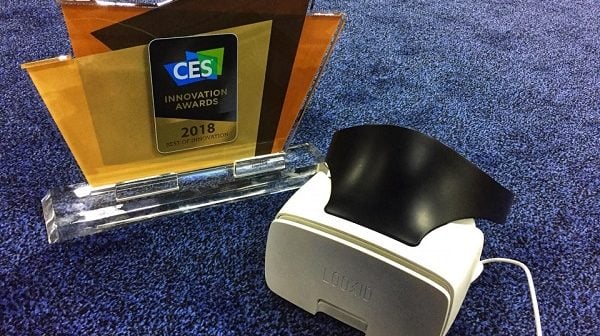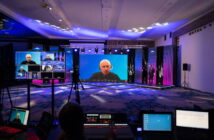The AR and VR markets in 2017
Last year, predictions said Virtual and Augmented Reality (VR/AR) would come out strong throughout the year. It is true we did see advancements in the technology from different companies. Apple seems to be working on a pair of AR smart glasses, and in September 2017 it released the ARKit, which turned out a success but has slowly fallen out of the spotlight. Nonetheless, Apple proved AR on smartphones can work properly, and maybe reliable AR smart glasses aren’t that far away.
On the other hand, Google replaced its Tango AR technology with the ARKit’s counterpart: ARCore. Unfortunately, news about this one disappeared even faster than Apple’s product.
In April 2017, we wrote about Avegant’s Light Field AR, the company who wants to compete with Microsoft HoloLens and Magic Leap. Speaking of which, Magic Leap’s announcement of a 2018-release for its first AR goggles is a welcoming news, seeing that the industry has been waiting for those since 2010. The question is: will it live up to the hype, and help to shape up the industry?
What about Virtual Reality? While Sony managed to exceed sale expectations with the PSVR—selling 2 million since launch last fall—and HTC Vive, as well as Oculus Rift, dropped prices from $799 to $599 and $798 to $399, respectively, the VR community is still a small one. Unfortunately, VR sells more as an expensive consumer product—for video games, movies, and live-experiences—than it does for commercial or industrial uses.
CES 2018 Overview
But what did CES 2018 bring to these markets?
 HTC’s upgraded Vive
HTC’s upgraded Vive
Although the most expensive, HTC Vive is one of the most reliable VR headsets you’ll find in the market right now. HTC is upping its game with the newest version of the headset announced at CES 2018: the HTC Vive Pro.
It features a 2880×1600 display (previously 2160×1200), and increases pixel density by 74 percent, reaching 615ppi. The headset comes with integrated headphones and dual mics, and will now use Valve’s updated SteamVR 2.0 tracking system, which allows for more accurate tracking. The company also showcased a wireless adaptor that will let users stream content wirelessly using Intel’s WiGig technology.
 Pimax 8K VR Headset
Pimax 8K VR Headset
Announced last year at CES 2017, Pimax brought the fifth version of its 8K VR headset to CES 2018. While the headset innovates with the 3840 x 2160 dual displays, and a 200-degree field of view, one of the complaints is the size and weight of the product.
Pimax’s 8K headset cost $449 during its kickstarter campaign, and the company plans to ship it during Q2 2018. However, taking into consideration you will need a high-end graphics cards to achieve an 8K resolution, it will cost you a bit more than that—unless you already own such a graphics card, of course.
 The Lenovo Mirage Solo
The Lenovo Mirage Solo
Lenovo Mirage Solo is the first headset to use Google WorldSense, an inside-out positional tracking technology. It costs less than $400 and equips a Qualcomm 835 chipset, 4GB of RAM, 64 gigs of onboard memory, dual mics, a headphone jack, and a 2560 x 1440 LCD screen. According to Lenovo, it runs for 7 hours on batteries.
 Oculus Go and Mi VR Standalone
Oculus Go and Mi VR Standalone
The China-based company, Xiaomi, partnered with Facebook for the release of two new VR products. Xiaomi will likely manufacture Facebook’s Oculus Go, and also release its own VR headset specifically for the Chinese market: the Mi VR.
Both headsets use a Qualcomm Snapdragon 821 system-on-a-chip, a WQHD LCD screen, and will run all Gear VR titles. They also look and work very similarly, although the Mi VR uses the Mi VR SDK while the Oculus Go uses the Oculus Platform SDK. The Oculus Go will cost $199, and assuming the Mi VR is basically the same product, the price shouldn’t vary too much.
 A brain-monitoring VR
A brain-monitoring VR
Startup Looxid Labs is creating a system for human behavior research. The LooxidVR headset packs two eye-tracking cameras and six EEG sensors, as well as HTC’s Vive X accelerator technology. By combining these technologies with VR experiences, Looxid Labs can measure a user’s eye and brain activities, obtaining valuable information about the user’s emotions. The company is looking to develop LooxidVR as a research tool, which could be very beneficial especially for the various use cases in medicine.
Can we really say that 2018 is that ‘ONE’ year that could change AR/ VR? I think we need to wait and look out for that. for now, lets hope for the best.
Because VR never the same as we were yesterday right? Follow us for more on AffinityVR for more, and do check out our site Archimaze for more developments.




